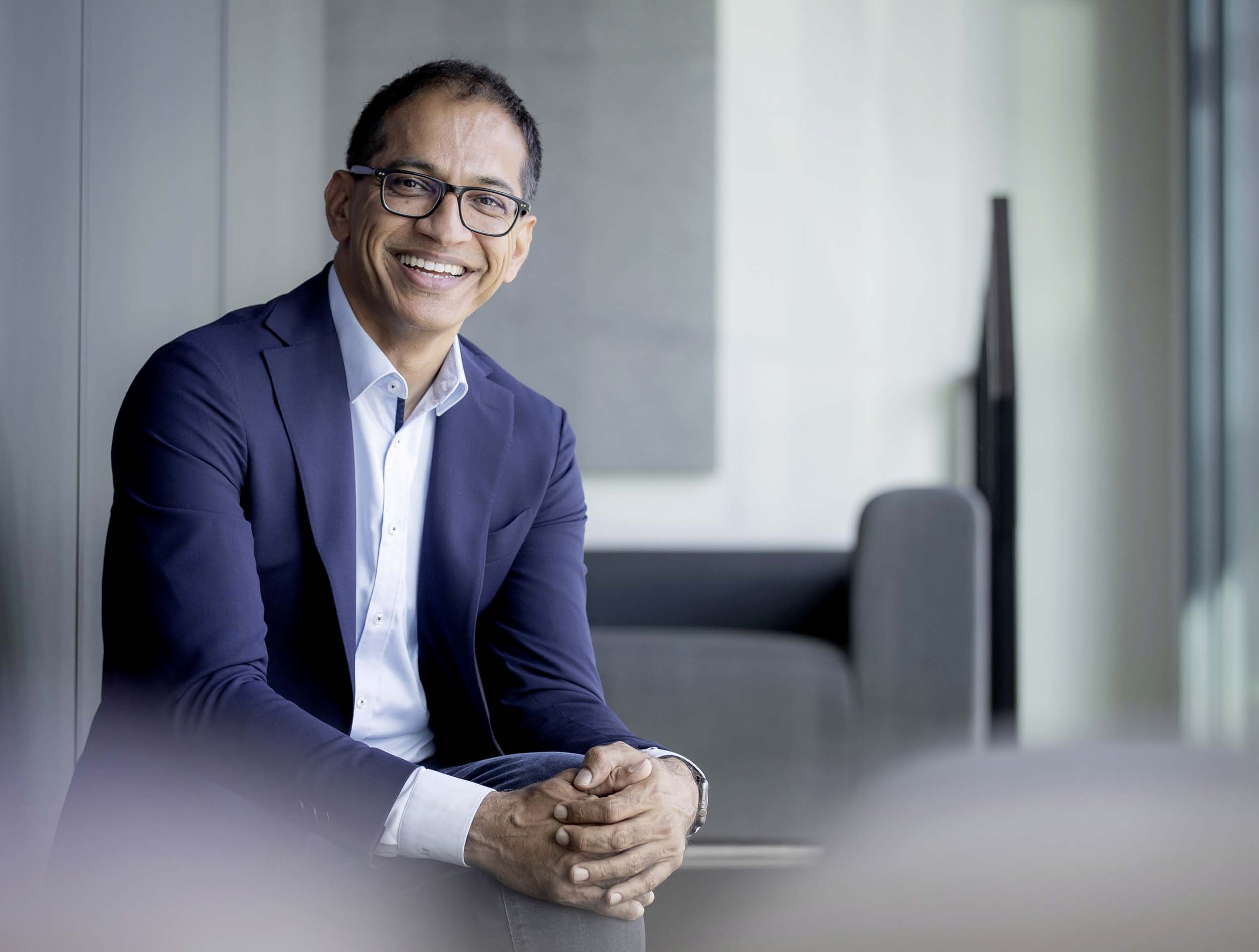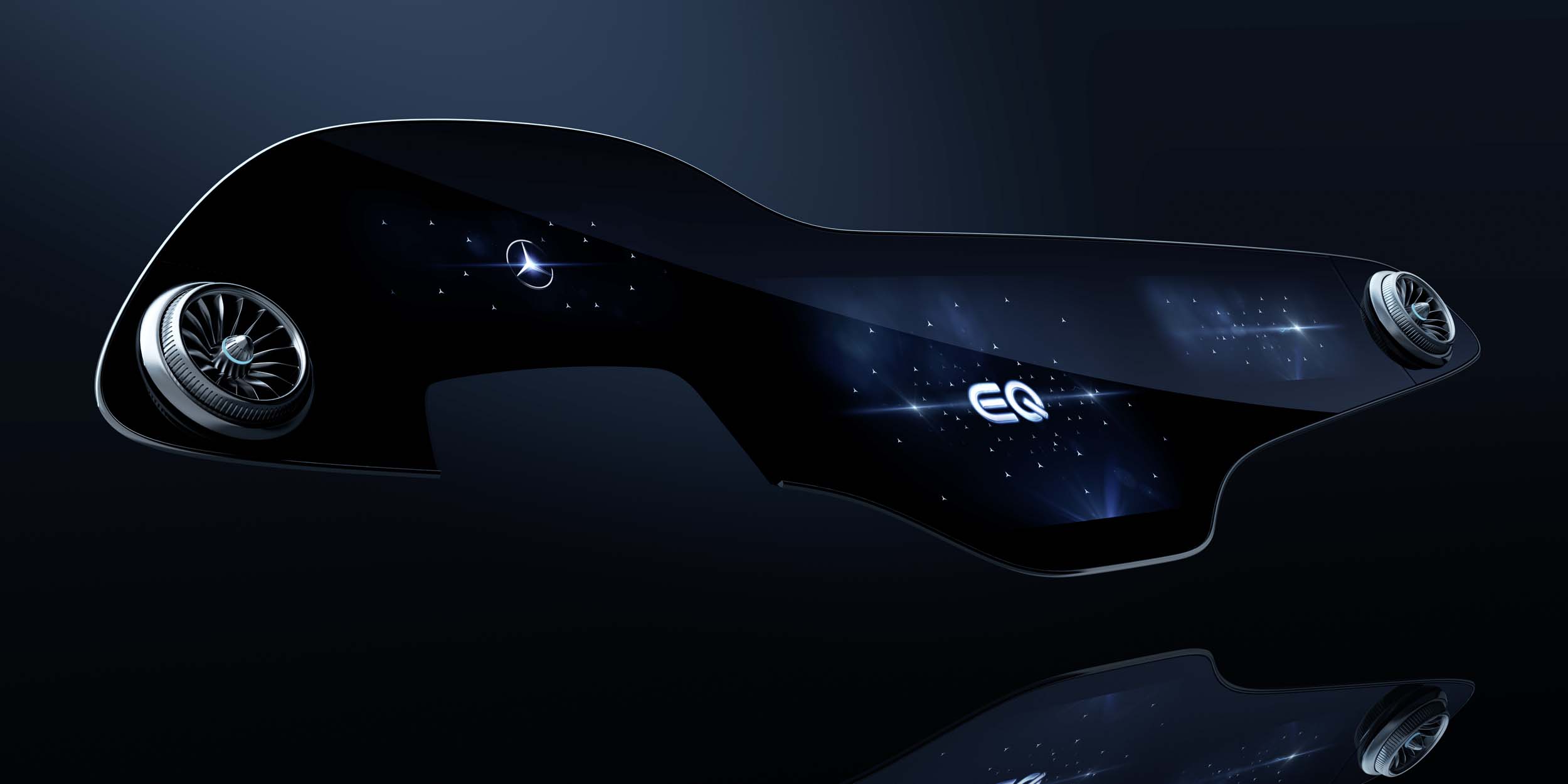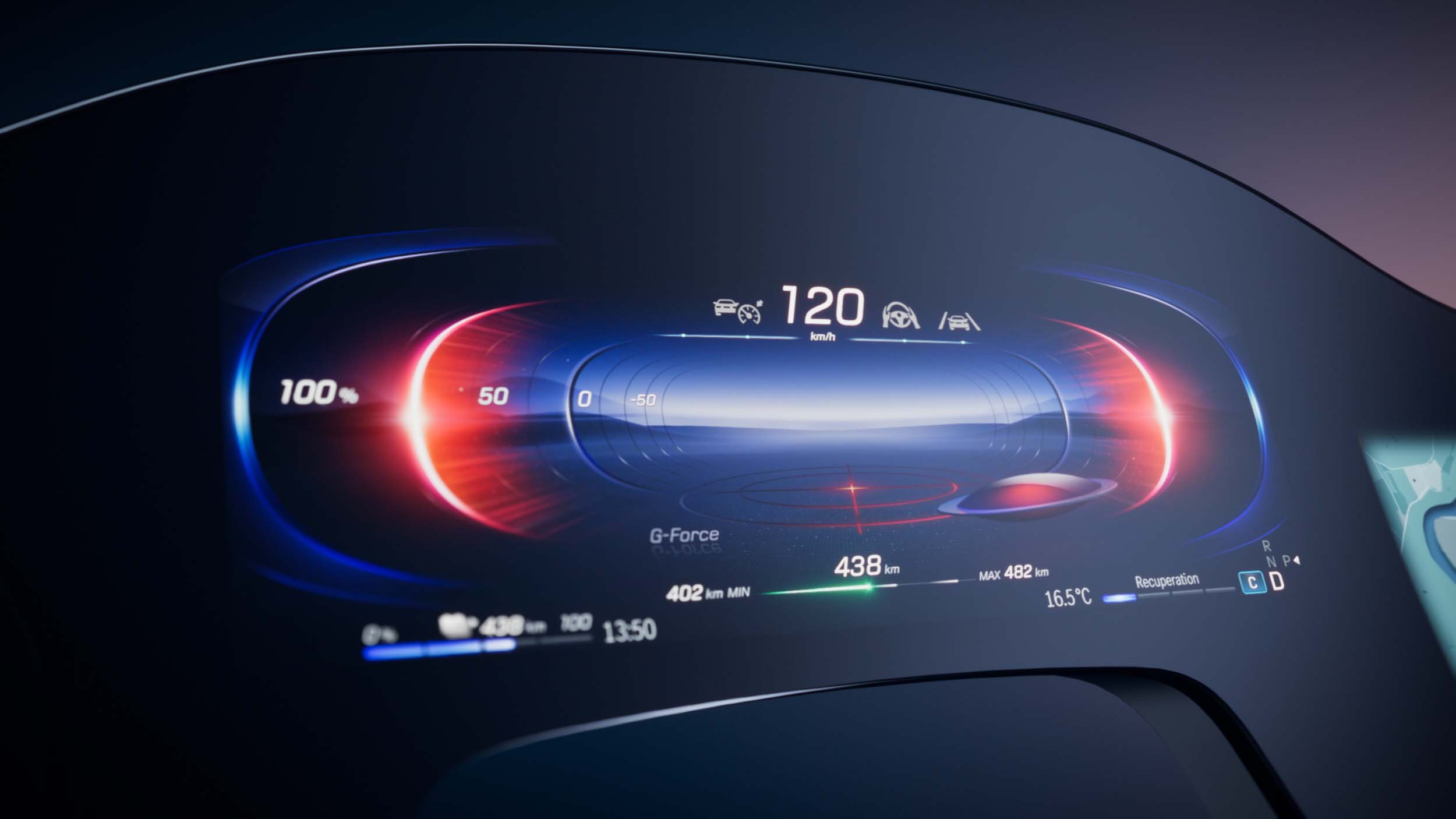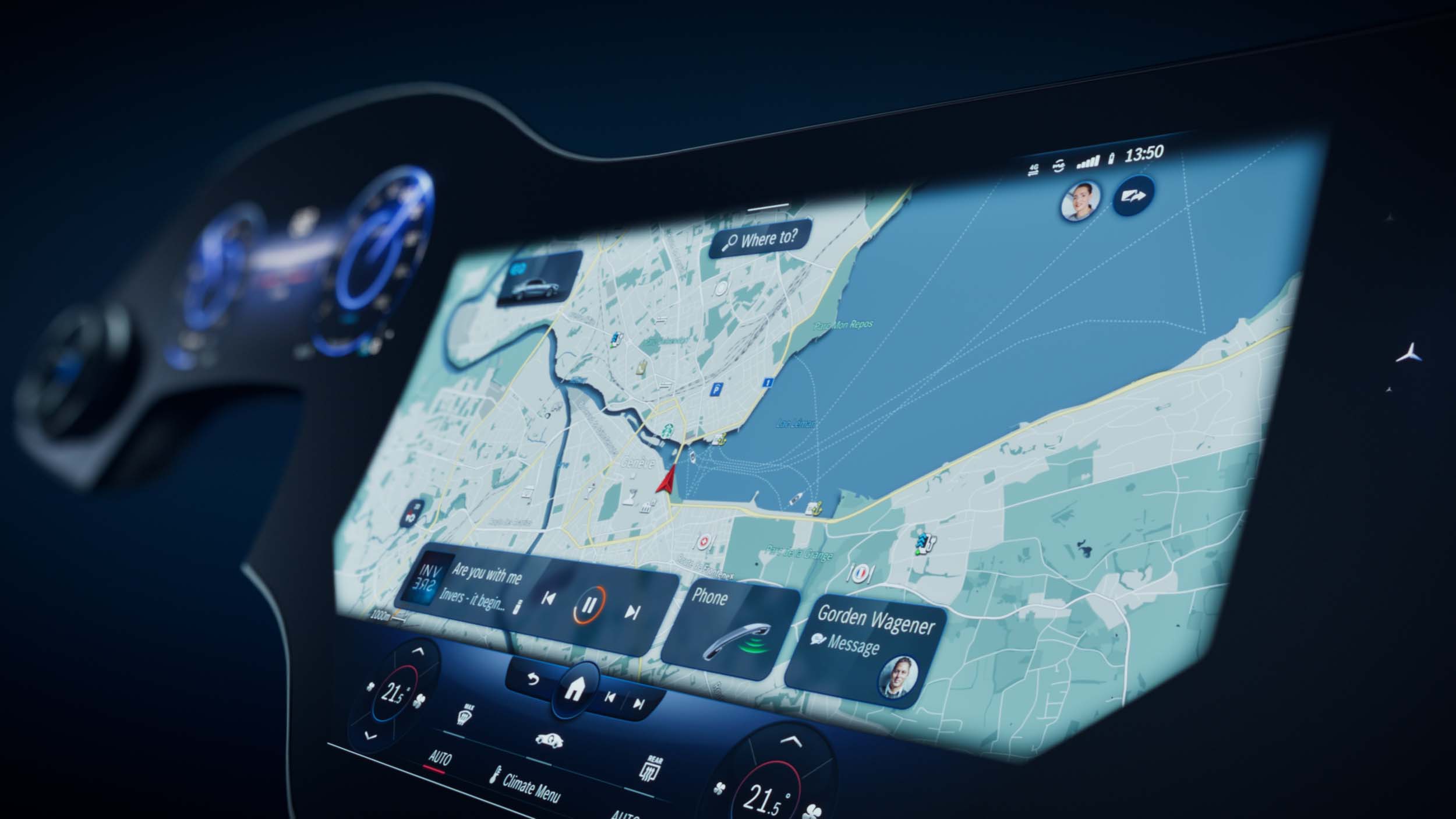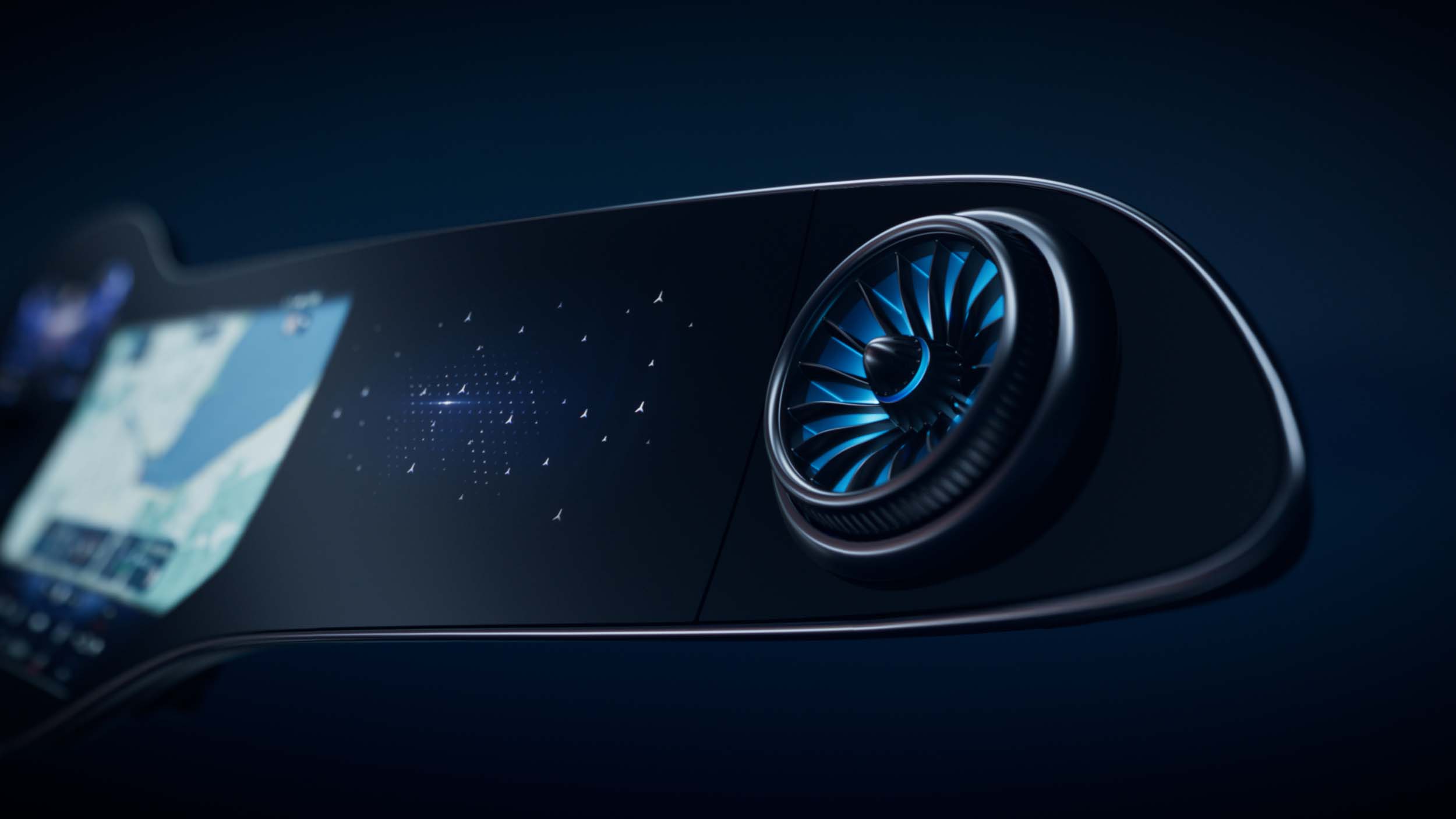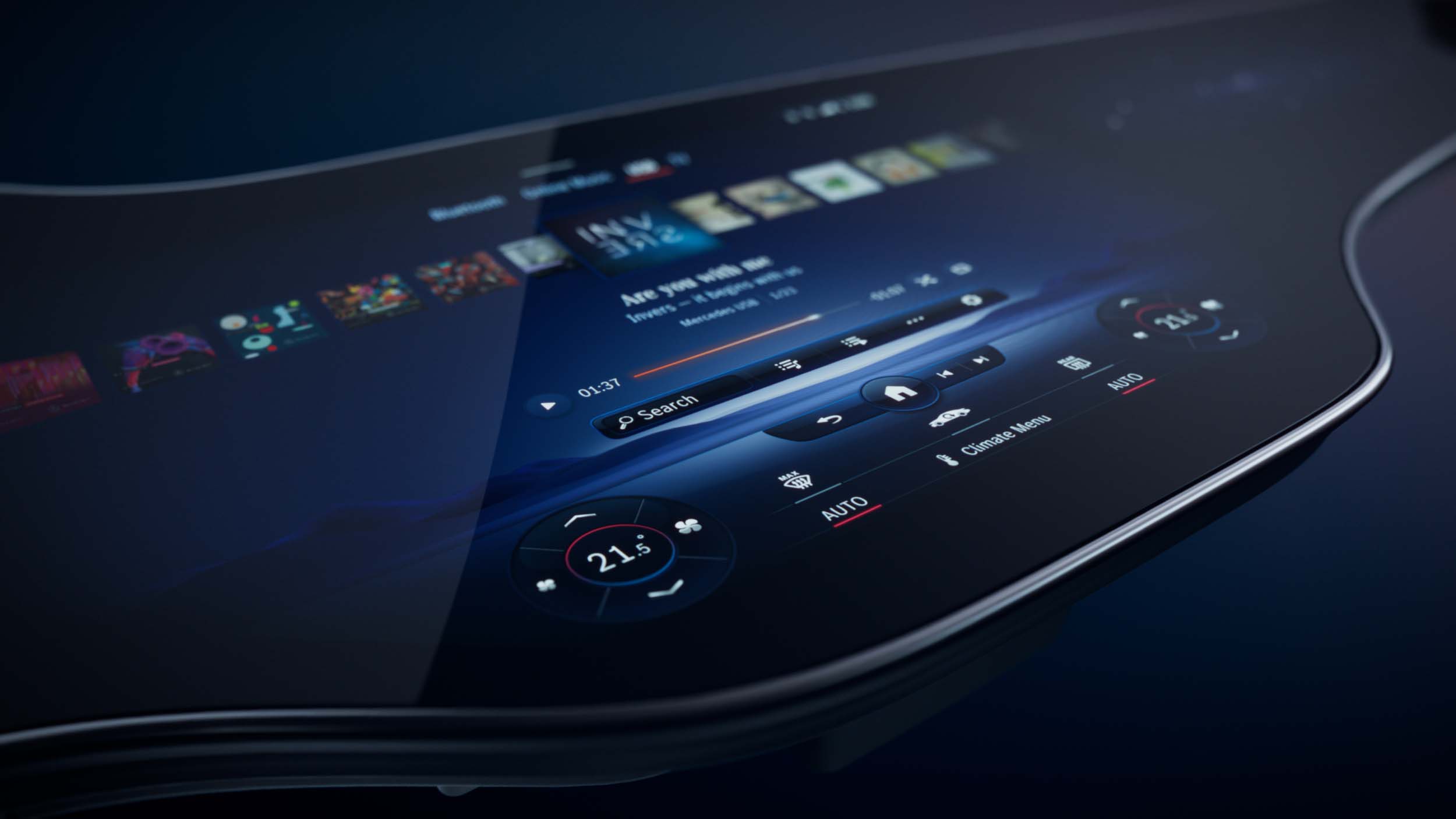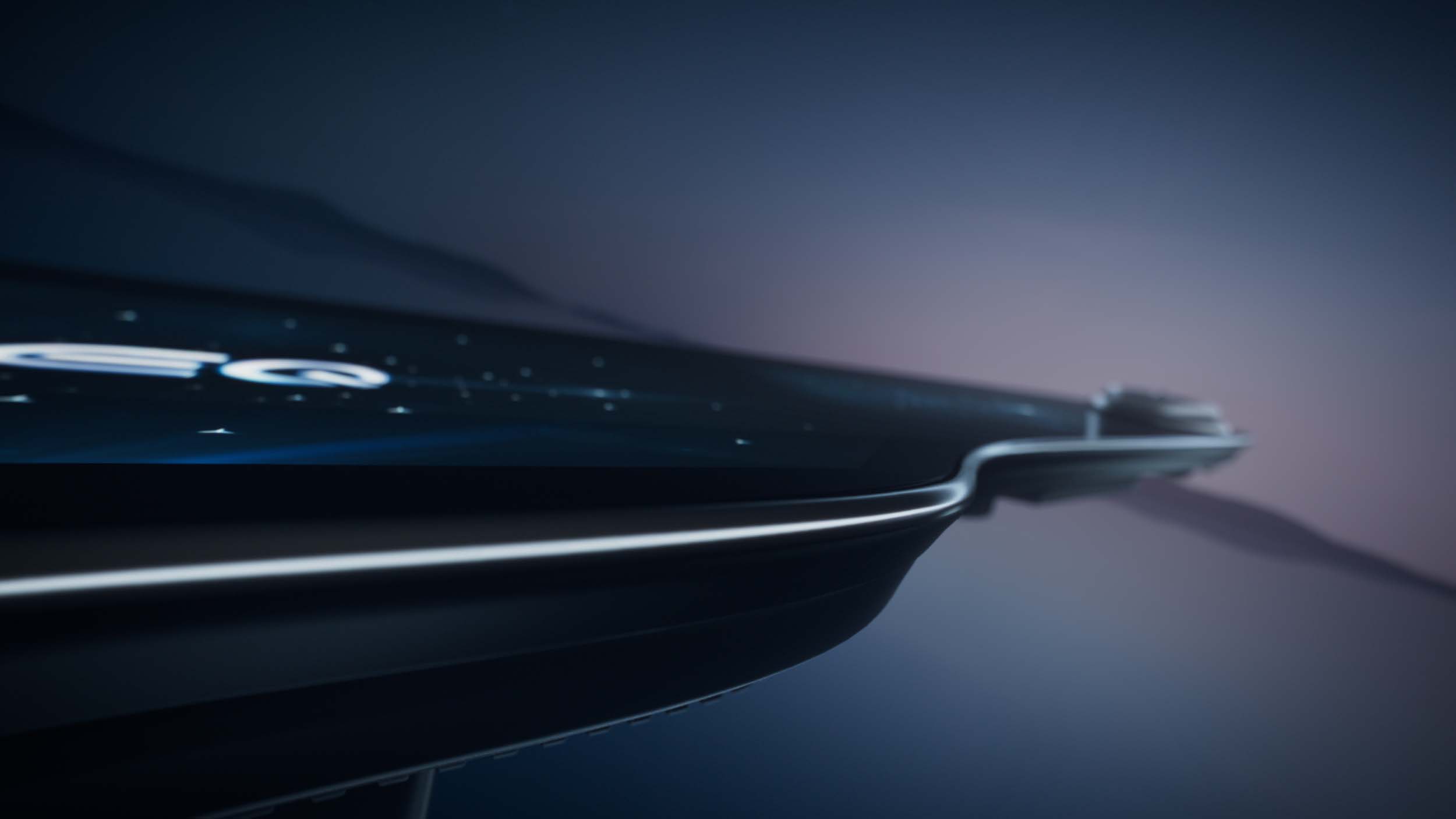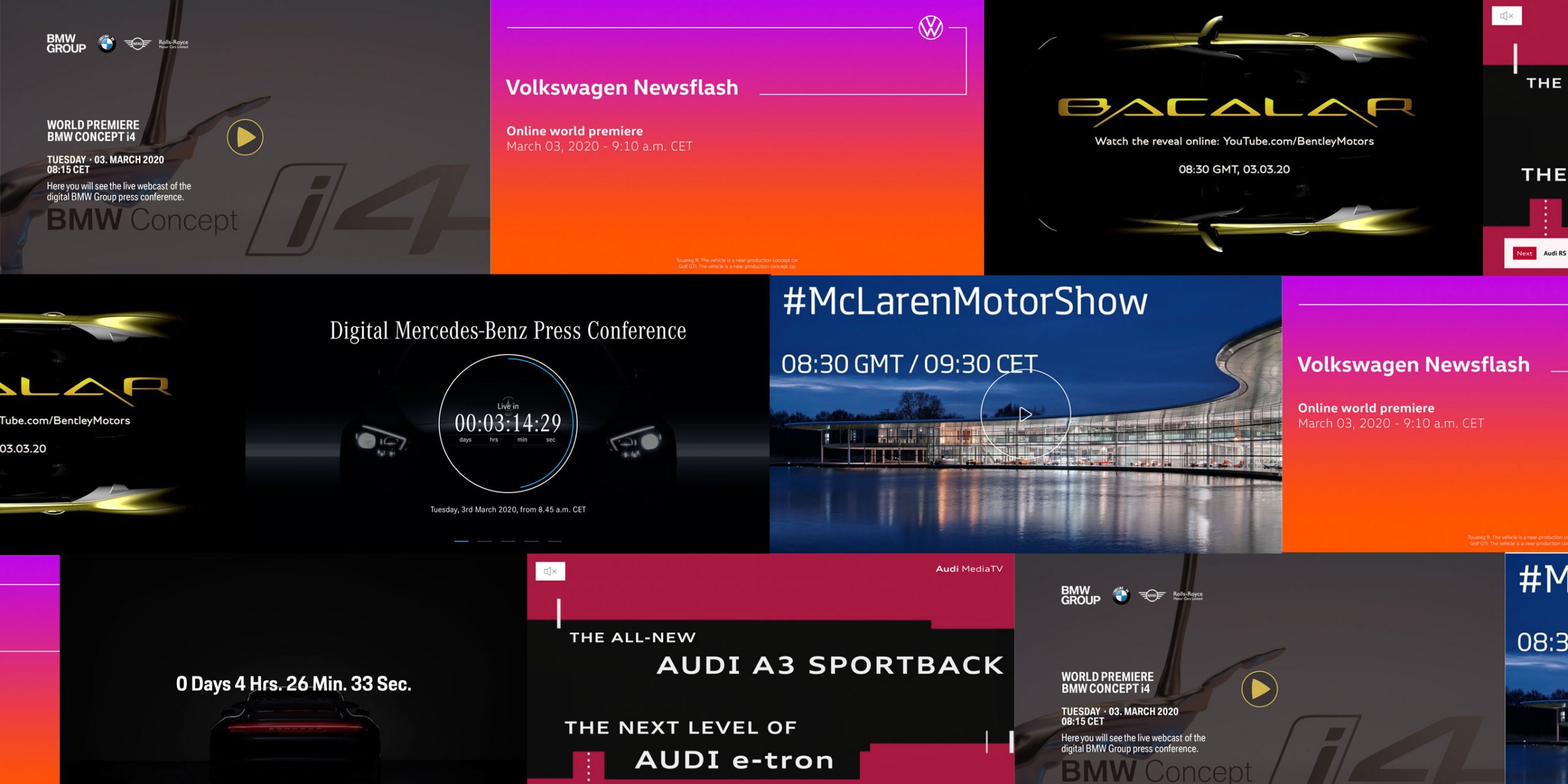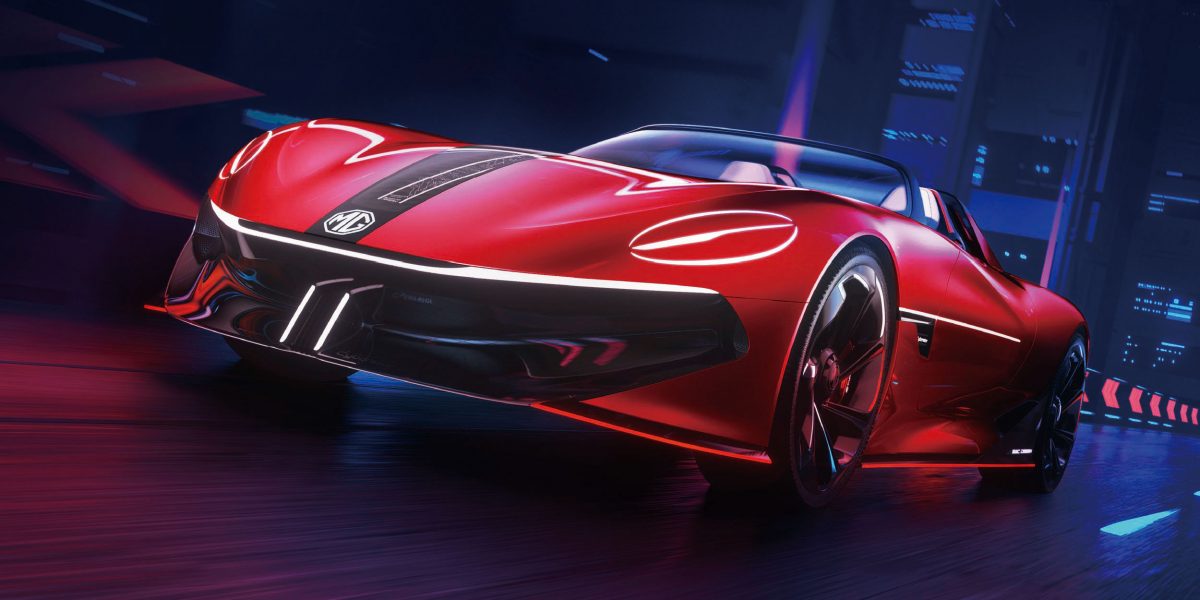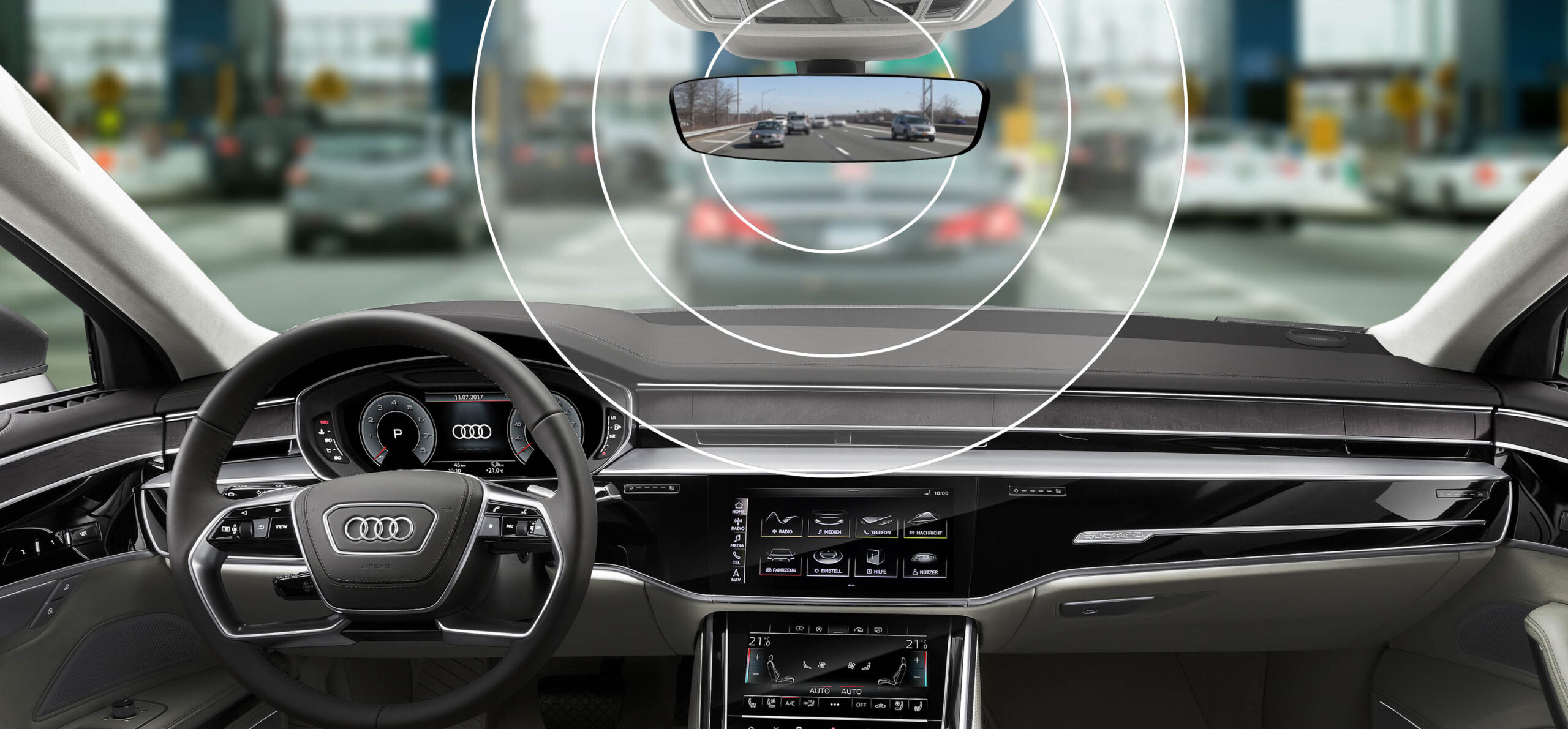EQS with unique MBUX Hyperscreen: the big picture
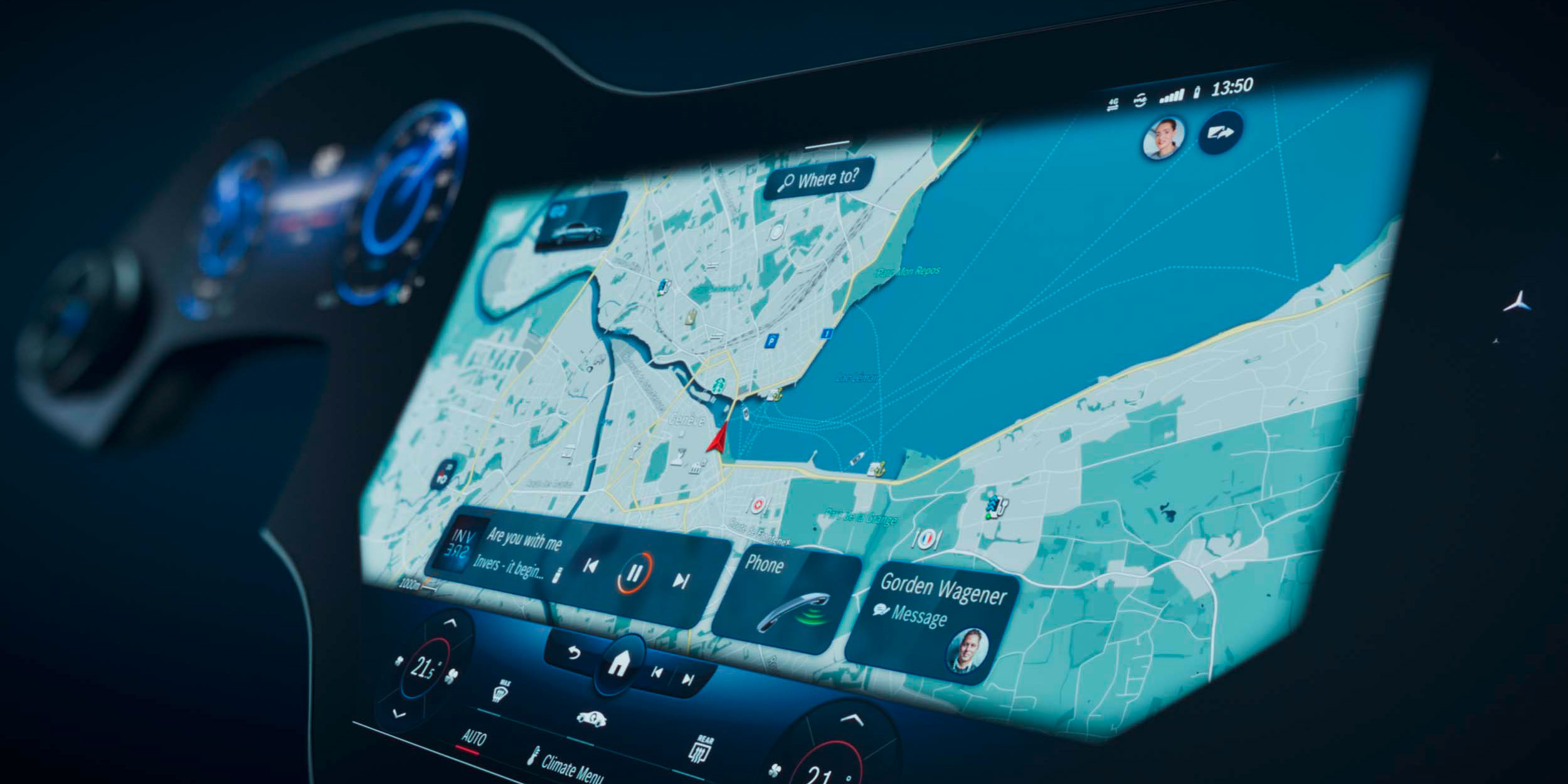
OFFERING AN ASSISTANT FOR THE DRIVER AND FRONT PASSENGER THAT IS CONSTANTLY LEARNING AND IMPROVING, THANKS TO ARTIFICIAL INTELLIGENCE
Visually impressive, radically easy to operate and extremely eager to learn: the MBUX Hyperscreen is one of the major highlights for the EQS. The Hyperscreen represents the emotional intelligence of the all-electric flagship model: The large, curved screen panel extends almost the entire width of the interior, from the left to the right A-pillar. In addition to its sheer size, the high-quality, detailed design aesthetic guarantees a “wow” effect. This high-tech aesthetic represents the emotionally appealing dimension of the MBUX Hyperscreen. Furthermore, artificial intelligence (AI) and learn-capable software, enables the control and display concept to adapt to its user and make personalized suggestions for a variety of functions from infotainment, to comfort and even vehicle functions. With the new zero-layer feature, the user no longer has to scroll through sub-menus or give voice commands, as the most important applications are always available in a situational and contextual way at the top of the driver’s field of vision. This alleviates the driver from needing to make numerous operating steps. The MBUX Hyperscreen not only benefits the driver as it is also an attentive assistant for the front passenger, who has their own display and operating area.
MBUX (Mercedes-Benz User Experience) has radically simplified the operation of Mercedes-Benz vehicles. It was first unveiled in 2018 in the A-Class, and there are now more than 1.8 million Mercedes-Benz passenger cars on the road equipped with MBUX worldwide. You can also find MBUX in the Van division. A few months ago, the second generation of this learn-capable system debuted in the new S-Class, and Mercedes is now taking another big step forward in the form of the new EQS and the optionally available MBUX Hyperscreen.
“With our MBUX Hyperscreen a design vision becomes reality,” says Gorden Wagener, Chief Design Officer Daimler Group. “We merge technology with design in a fascinating way that offers the customer unprecedented ease of use. We love the simplicity we created with a new level of MBUX.”
“The MBUX Hyperscreen is both the brain and nervous system of the car,” says Sajjad Khan, Member of the Board of Management of Mercedes-Benz AG and CTO. “The MBUX Hyperscreen continually gets to know the customer better and delivers a tailored, personalized infotainment and operating offerings without the occupant needing to click or scroll anywhere.”
Electrifying appearance with emotional visualization
The MBUX Hyperscreen is an example of digital/analogue design fusion: several displays appear to blend seamlessly, resulting in an impressive, curved screen band, while analogue air vents are integrated into this large digital surface to connect the digital and physical world.
The MBUX Hyperscreen is surrounded by a continuous plastic front frame. This visible part is painted in “Silver Shadow” that undergoes an extensive three-coating process to achieve a high-quality surface impression through extremely thin intermediate coats. The integrated ambient lighting installed in the lower part of the MBUX Hyperscreen makes the display unit appear to float on the instrument panel.
The front passenger is also given their own display and operating area, to help make road trips more enjoyable and entertaining. The passenger display allows for individualized content with up to seven profiles. However, the entertainment functions of the passenger’s display are only available during the journey within the framework of the country-specific legal regulations. If the passenger seat is not occupied the screen becomes a digital decorative part. In this case, animated stars i.e. the Mercedes-Benz pattern, are displayed.
For a particularly brilliant image, OLED technology is used for the central and front passenger displays, providing an especially brilliant image. This technology features individual image pixels that are self-luminous; image pixels, when they are not used it remains switched off, which means that they appear deep black. The active OLED pixels radiate with a high color brilliance, resulting in high contrast values, regardless of the angle of view and light conditions.
This electrifying display appearance goes hand in hand with emotionally appealing visualization. All of the graphics are styled in a new blue/orange color scheme throughout. The classic cockpit display with two circular instruments has been refreshed with an all-new digital look.
Thanks to its clear design, the MBUX Hyperscreen is intuitive and easy to operate. One example of this is the EV display, important functions of the electric drive such as boost or recuperation are visualized in a new way, with a spatially moving clasp, making it tangible for the user. A lens-shaped object moves between these clamps, which follows gravity and thus is able to impressively depict the G-Force.
Personalized suggestions with the aid of artificial intelligence
Infotainment systems offer numerous and extensive functions, typically with several operating steps often required to control them. In order to reduce these interactive steps even further, with the aid of artificial intelligence, Mercedes-Benz has developed a user interface with context-sensitive awareness.
The MBUX system proactively displays the desired functions at the appropriate time for the user, supported by artificial intelligence (see below for examples). The context-sensitive awareness is constantly optimized, both by changes in the surroundings and user behavior. The zero-layer provides the user with dynamic, aggregated content from the entire MBUX system and related services, at the top of the MBUX information architecture.
Mercedes-Benz has researched the usage behavior of the first MBUX generation, and learned that most of the use cases fall in the Navigation, Radio/Media and Phone categories. Therefore, the navigation application is always at the center of the screen unit with full functionality for ease of use. Over 20 further functions – from the active massage program to a birthday reminder, and suggestions for a to-do list – are automatically offered with the aid of artificial intelligence, if they are relevant to the customer. “Magic Modules” is the in- house name the developers have given to these suggestion modules, which are shown on the zero-layer.
Here are four use case examples. The user can either accept or reject the respective suggestion with just one click:
- If you always call one particular person on the way home on Tuesday evenings, you will be asked to make a corresponding call on that day of the week and that specific time of day. A business card appears with their contact information and – if it’s stored – their photo will appear. All MBUX suggestions are linked to the user’s profile. If someone else drives the EQS on a Tuesday evening, this recommendation would not be made – or another one is made, depending on the preferences of the other user.
- If the EQS driver regularly uses the hot-stone massage function featured in the optionally available Active Multicountour Seats, the system learns and automatically suggests the hot-stone massage function for the driver in colder temperatures.
- If the user regularly uses both the heated steering wheel and heated seat functions together, MBUX intelligently suggests to enable the heated steering wheel as soon as the user turns on the heated seat.
- The suspension of the EQS can be raised in order to offer more ground clearance. A useful function for steep driveways or speedbumps to create a smoother ride. MBUX remembers the GPS position where the user utilized the “Raise Vehicle” function. If the vehicle approaches this GPS position again, MBUX automatically suggests raising the EQS.
Interesting facts & figures
With the MBUX Hyperscreen, several displays appear to merge seamlessly, resulting in an impressive, curved screen band over 56 inches wide. The surface area for the passengers is 377 sq. in.
The large glass cover display is curved three-dimensionally in the molding process at temperatures of approx. 1202°F. This process allows a distortion-free view of the display unit across the entire width of the vehicle, irrespective of the display cover radius.
To access the most important applications, the user scrolls through 0 menu levels. This is why Mercedes- Benz calls this the zero-layer.
There are a total of 12 actuators beneath the touchscreen for haptic feedback during operation. If the finger touches certain points there, they trigger a tangible vibration in the cover plate.
Two coatings of the cover plate reduce reflections and make cleaning easier. The curved glass itself consists of particularly scratch-resistant aluminum silicate.
The safety measures include predetermined breaking points alongside the side outlet openings as well as five holders which can yield in a targeted manner in a crash thanks to their honeycomb structure.
8 CPU cores, 24-gigabyte RAM and 46.4 GB per second RAM memory bandwidth are some of the MBUX technical specifications.
With the measurement data of a 1 multifunction camera and also 1 light sensor the brightness of the screen is adapted to the ambient conditions.
With up to seven profiles, the display section can be individualized for multiple front passengers.
“The MBUX hyperscreen is both the brain and nervous system of the car”
Interview on MBUX (Mercedes-Benz User Experience)
Gorden Wagener, Chief Design Officer Daimler Group, and Sajjad Khan, Member of the Board of Management of Mercedes-Benz AG and CTO, on the new MBUX generation.
Mr Wagener, the new MBUX generation can do more, knows more, says more: When was the last time you said “Hey Mercedes!”? And if it is not too indiscreet, what were your commands or questions to the voice assistant?
Wagener: That was less than 15 minutes ago on the way to the office. When I use MBUX, then intuitively, I didn’t have to think about whether and how. When we look at the thinking of my parents’ generation they were asking: do I want to use technology? It’s completely different today, the fusion of technology and design makes it so easy: I want to use this technology. If technology can do a lot, but I have to work out the usage, I always stay at a distance. That’s why it was important that our success is based on the idea that it must work just as well as it looks.
In January 2018, you presented the first MBUX generation at CES in Las Vegas. What was it like to present the car cockpit of the future as an automobile manufacturer at a trade fair for consumer electronics?
Khan: The days leading up to the world premiere of MBUX in Las Vegas were a very exciting time for my team and me. Will we be able to complete the extensive programming in good time? Does the live demo work in the seating boxes? And will journalists realize the potential of MBUX? But we were lucky enough to be able to: Everything worked wonderfully, and the media representatives and the audience were thrilled. Just four months later, the new A-Class was launched as the first model with MBUX. In the meantime, more than 1.8 million Mercedes-Benz cars are on the road, and the van sector also relies on MBUX. A new Mercedes without MBUX is already unthinkable. We are now building on the absolute success story with the second MBUX generation.
Wagener: The Las Vegas trade fair was just the right place for the world premiere of MBUX: The abbreviation CES stands for Consumer Electronics Show, but CES has become an important tech trade show. This reflects the increasing digitization and networking of all areas of life. Like seismographs worldwide, my design colleagues in our four international design studios are feeling exactly these trends and are inspired by new ideas from other continents and cultures, their field of work is the future. A visit to CES has always been very inspiring, especially when it comes to topics such as user experience or trends such as “Fit & healthy”.
With the 3D driver display with real depth effect, the large head-up display with augmented reality content such as animated turn arrows and biometric authentication, MBUX has now taken another big step towards digitization and artificial intelligence. And, if you will, you could say that with the MBUX hyperscreen even the giant TV has now found its way into the car. What are the highlights of the new MBUX generation for you?
Khan: Of course, I have personal favorites, and this includes the huge MBUX hyperscreen in the EQS. With its unique electro-aesthetics and high user-friendliness, it represents the entire character of the EQS – avant- garde, cool, personal and useful – the German word “practical” simply does not match it as perfectly as the English term. But it is very important to me not only to talk about individual hardware components of MBUX. The clever networking of all systems and the intelligent software that can be learned are also crucial. Our MBUX philosophy is to offer our customers maximum comfort, personalization and amenities. A system that goes into even more detail, is more thoughtful and individual than ever before. The advantage for our customers: Thanks to the optimized user-friendliness, they save time and get a high added value. MBUX becomes the backbone or even the central brain of the vehicle.
Wagener: With MBUX, our goal was to create the most desirable automotive infotainment system. We have transferred the bipolarity of our design philosophy Sensual Purity to MBUX – that is, on the one hand the sensual beauty and on the other the ‘wow effect’ of the uniquely intuitive operation. And with the EQS as a representative of Progressive Luxury, we were able to be a little more modern, bolder and more polarizing. By the way also in the exterior. I agree with Sajjad, my absolute favorite feature in the interior is the MBUX Hyperscreen. We have thus invented a new interface that brings design and technology together. The MBUX Hyperscreen was born: a digital piece of art, a futuristic, luxurious sculpture and also a huge technological challenge.
But digital beauty is just one aspect of MBUX, isn’t it? How has MBUX’s pronounced usability been further enhanced?
Wagener: We stage technology through design in a way that is fun and beautiful at the same time. And above all, it is intuitive to use. In addition to cool hardware, the content and handling are also crucial, i.e. what we show on the screen unit and how it can be used by the customer. We have a high optical standard, with finely worked out detail. Our zero layer is another example of the ease of operation, where the most important and most commonly used interactions can be operated on a single, top-level. You rarely have to dive into submenus and thus shorten the interaction time. This is a continuation of intuitive operation and is part of the ’emotional intelligence’ of our Mercedes-EQ brand.
Khan: Yes, the MBUX hyperscreen is at the same time brain and nervous system of the car, it is connected to all components of the vehicle and communicates with them. This allows for a new form of interactivity and individuality. This is because the customer is at the center of development. We analyzed the customer feedback of the first MBUX generation and asked ourselves: ”What do people need and how do they interact in the car? Especially in an electric car?’ The goal was a concept without distraction of the driver or creating complicated operation. And it had to be able to learn thanks to artificial intelligence: The MBUX Hyperscreen gets to know the customer better and better, providing customized, personalized infotainment and operating offers before the passenger has to click anything. We didn’t want to build the biggest screen ever in a car.
Instead, we have developed special screens with a perfect ratio of size and functionality for maximum user- friendliness. This is customer orientation and digital thinking 2021!
